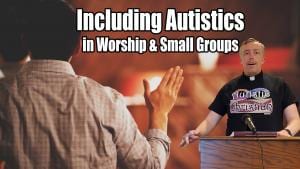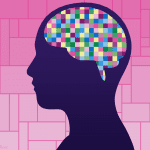I was scheduled to give this talk at InclusionFest Live run by Key Ministry in the Cleveland area this April. But due to coronavirus, everything was shut down. I don’t like to leave things to the last minute – I’m not sure if that is an autistic trait or not – so I had already prepared the talk before the event was canceled. As the talk was already written, I offer you a recording of this talk on welcoming autistics in worship and small groups. Although I’m obviously a Catholic priest and most videos I do are explicitly Catholic, this video was for a conference open to all Christian denominations. Thus, I use language that is more inclusive to all Christians. I hope this helps Catholics, Protestants, and Orthodox. I want to thank Stephanie Bethany, an autistic Protestant YouTuber, for reviewing the text to make sure it was inclusive for Protestants.
Here’s the Video: The Text Is Below
The text below is my written script beforehand. I followed it pretty close, although not exactly.
Introduction
When I walked on stage and you saw my shirt [point to shirt], you could have probably already guessed my theme. This is probably the only national conference where I can come out wearing a shirt with the word “autistic” with a Roman Collar while playing with a fidget toy, and not seem out of place. I am one of the few Christian ministers out there who is also openly autistic. Autism is a different way of processing the world, and it requires some help from the local church, but it should not be an obstacle to participation in most ministries. I want to explain some elements for including autistics in ministry, but first a little about myself.
My Story
I am a Catholic priest, an autistic Catholic priest. As a child, I never quite fit in well, and had a few other struggles that looking back now, I realize was clearly autism. However, the diagnostic criteria were different then. A few in my extended family are also on the spectrum so within the family it wasn’t considered so unusual. In my family, we tend to be research scientists and engineers. Most are not autistic, but in a family like that autistic traits don’t stand out as much as they would in most families. For example, I’m a doctoral candidate in theology.
In my second year of computer engineering, I felt God calling me to be a priest so I switched and enrolled in seminary the following fall. I got through seminary all right and was assigned to be a school chaplain, a normal job for a newly ordained priest or pastor. After a year, they told me they didn’t want me back and said I should look into Asperger’s. I was a little downtrodden as I thought I’d just made a few mistakes common to learning any new job; however, I guess I’d totally missed on reading kids social cues and I’d kind of burned myself out trying to act, all day. A year later, I actually got a formal diagnosis.
Again, going home I was devastated. But as I read up on Autism, so many things in my life finally made sense. I had to ask others if most people did certain things subconsciously as I always did them with conscious effort and didn’t realize how much easier social interaction is for most of you. It was like I had struggled to distinguish colors my whole life but managed to be passable then got diagnosed with colorblindness. Soon after, I made two decisions. First, I would be public about this for my own good and to promote ministries to fellow autistics. Second, I would do a doctorate to be a writer or professor as that would fit as a better ministry for my talents as a smart but autistic Catholic priest.
What is Autism?
Autism is not kind of one thing like many conditions. It is not homogenous as it’s more like if you check at least 6 of 10 boxes, you are autistic. So, two autistics might have little overlap. On top of that, some boxes indicate an irregularity but not which direction. One box, for example, irregularities in sensory processing, has the opposites: hypersensitivity or hypersensitivity. The stereotype of a hyposensitive autistic person’s office is dark with little light but my office, which I adjusted myself, is so bright people make comments about it. However, even liking very bright light, I’m one of the first to put on sunglasses on a bright day: my range of enjoyable light is smaller than average.
Now, let’s look at a few of these boxes. Two small notes: first, the 10 boxes is not an exact clinical definition but is more a simplified approximation. Second, I’ll focus specifically on autistic things, and assume you all know general points for those who are different or disabled.
Autistic Sensory Issues
One of the first things many know about us autistics is that we often have sensory issues. When people try to do videos showing autism from the inside, they tend to focus on this. was planning to show part of one when doing this talk live but I am poor and the autism charity wanted to a license fee. Imagine if every fluorescent light felt like a strobe light. Or imagine if what most people consider normal sounds felt like cymbals clanging a foot from your ear or fingernails on a chalkboard. Or imagine if the tag on the back of your shirt felt like a cat’s claws tearing into your back. These are the types of things autistics describe when talking about their hypersensitivity.
The issue for us is not in the senses themselves but in how we process them in our brain. For example, many times an autistic will be fine with loud volume but struggle with multiple voices at once. When our senses get too much over a period of time, we’ll go into overload protection and either shutdown or meltdown.
Sensory Issues and Small Groups
It is generally easy to make small groups accessible for this aspect of autism. However, check with the individual from specific sensory issues. One common one is we often notice the flicker of fluorescent lights: these flash on and off many times a second: most perceive this as constant light but for some of us, they feel like strobe lights.
Sensory Issues and Worship
In worship, sensory issues often present more of a challenge as we often have music, voices, lights, etc. all at once. If a contemporary worship style is used, the tendency to sensory overload can be even stronger. One of the easiest ways to resolve this is what I call the reverse cry-room. Many churches have an area separated by glass from the main worship space that is often used for crying babies or similar. Usually, this has separate controls for lighting, sound, etc. so setting these low at one service would be a huge help for autistics.
Another option is having a sensory-friendly liturgy every week where things like this are done for the whole church. Sometimes a few local churches might work together to support a weekly service like this. Such a space also allows for autistics to not worry about some other aspects.
Autistic Struggles with Social Interaction
We autistics also struggle with social Interaction and non-verbal communication. As noted above, I was diagnosed when I couldn’t read the facial expressions and non-verbal cues of students where I was a chaplain. Some struggle so much they are not able to do this at all while others like myself can generally do a passable, but below average, job.
When we do this, we are often doing consciously things that most humans do subconsciously. For analogy, imagine if you needed to think of each muscle contraction and relaxation needed to walk 20 feet [walk a bit] and it wasn’t just automatic that I decided walk over here and my subconscious brain controlled my exact muscle movements in unison. Walking around would be mentally exhausting.
A related thing is that most of us autistics have more trouble identifying faces: some have complete Prosopagnosia where they can’t even identify family members while others like me will have to ask you your name 20 times before we link name and face.
Social Interaction in Small Groups
For this, participation in worship is not as much of an issue. However, this can be a huge issue in small groups.
If you have several autistics, a good way would be to make an autistic small group as we tend to communicate better with each other than with neurotypicals. If that doesn’t work out, you need to help people learn a bit about how this autistic person does social relationships. If you want to know how an autistic is feeling, ask us. If we sense you care about us as individuals, we’ll tell you straight up. Some of us will use the standard social scripts of “fine, how about you?” when asked how we are doing if we feel we have to fake it with you. At the same time, tell us how you’re feeling. Most other people get how you’re feeling from your face. I might be able to, but might not.
As well, please realize we’ll seem awkward to you. Give us a chance to talk but also be clear when you’re done so we know when to speak. As we are doing a bit of a guessing game for things like, “you’re done speaking so I can speak now,” please excuse us if we seem rude in stuff like this. Some autistics might want to be rude but I can tell you that any apparent rudeness coming from us willingly attending Christian services is accidental.
It is a lot like if you’ve ever worked with Spanish speakers learning English: Spanish doesn’t distinguish certain vowels that English does. I saw a preview of The Passion of the Christ with a fellow Seminarian who just came from Latin America. After the movie, he asked me about the snack in the movie. Wondering what in tarnation he meant, I asked him and he talked about Jesus stepping on the head of the snack in the garden. I knew that this seminarian was trying to say “snake,” not be a jerk when he made this error. The same goes for autistic misunderstandings.
When speaking, words have the same denotative meaning, a dog is still a dog. However, connotative meanings are often lost on us. You might say, in a way you think is an obvious joke, “Let’s go run across the frozen pond,” but see the autistic in the group starting to get dressed to go outside.
Hence, sometimes this will also cause certain misunderstandings. Usually, these are easy to clear up but a few things should probably be avoided with someone you know is autistic. For one, most of us don’t get friendly teasing and banter. I remember one time a big shot was visiting and I made a small mistake cleaning, someone else working in ministry made a big deal about it so much so that I spent the whole meeting worrying about that cleaning spot, only for my coworker to say he was just teasing afterwards. He didn’t even think it was a big enough issue to say sorry for but I was hurt.
Autistic Schedules and Repeated Behaviors
I want to briefly touch on two other things we should try to accommodate if we want autistic participants and ministers: schedules and repeated behaviors. Repeated behaviors are simple. If you know someone is autistic and you see them fidgeting with a stim toy as I have been or flapping their hands [demonstrate], just let them be and realize this is just part of who they are. This is often either involuntary or stress-relieving. Schedules, on the other hand, take some work: we like regularity or at least knowledge of what is coming.
This affects both worship and small groups. If you have a special one for just us autistics, just use the same songs every week. I know that doesn’t sound as interesting for most people but we’d prefer it. Second, let them know what is coming. If I know the schedule, I can manage the issues I have a lot better. If I don’t know if there will be 2 or 5 songs before the preacher, Sunday service will be more nerve-wracking than if someone told me beforehand or handed me a program.
Liturgical churches obviously have an advantage here as the liturgy has a certain set order. If I go to almost any Catholic church, they begin with one song, then a few opening prayers, then have 4 biblical readings, then preaching, then the creed, then another song, then the prayer of consecration, then Communion with a song, then closing prayers and a closing song. That gives me a good solid foundation to know what’s going on. Maybe less liturgical churches have a similar structure to worship but the few times I attended, it did not seem as consistent to me.
Conclusion
Finally, there’s an important lesson that Bob Quinlan of the National Catholic Partnership on disabilities told me just days before I was diagnosed. He said, “Regarding the people with disabilities, I’m not just trying to help them out on a one-way channel that comes back and helps me; I want to help them become good, to help them to give back as they can.” This means we should invite autistics in not just to receive but also to give.
There are a handful who have talked about autism as ministers – Dr. Lamar Hardwick who is an African-American baptism pastor down in Georgia was one of the first and I’ve shared my own story far more than my brief intro here.
Google it if you want. However, I still think our gifts are often underutilized in so many ministries we could do. We should make the church environment so we can include autistics with things like a reverse cry room or handing them a program to know what’s happening, but it should not stop there: we should find ways that we autistics can use our talents to build the Church.
Note: Please support me on Patreon so I can keep making content like this.













